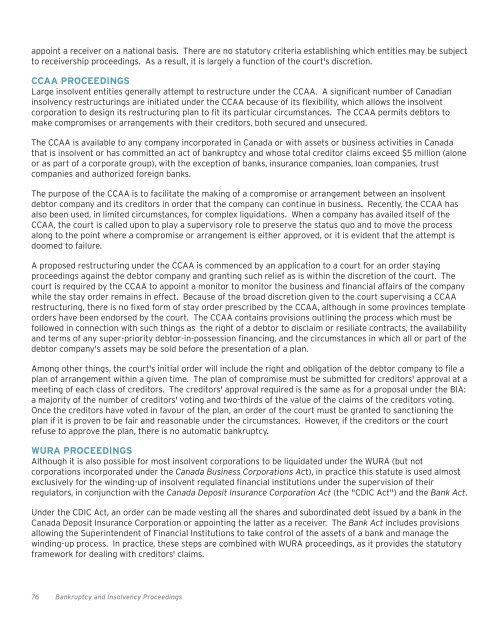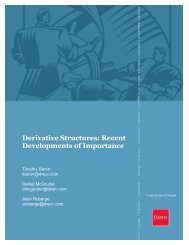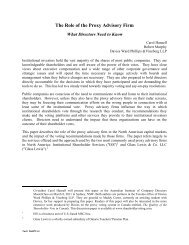doing business in canada - Davies Ward Phillips & Vineberg LLP
doing business in canada - Davies Ward Phillips & Vineberg LLP
doing business in canada - Davies Ward Phillips & Vineberg LLP
- No tags were found...
You also want an ePaper? Increase the reach of your titles
YUMPU automatically turns print PDFs into web optimized ePapers that Google loves.
appo<strong>in</strong>t a receiver on a national basis. There are no statutory criteria establish<strong>in</strong>g which entities may be subjectto receivership proceed<strong>in</strong>gs. As a result, it is largely a function of the court's discretion.CCAA PROCEEDINGSLarge <strong>in</strong>solvent entities generally attempt to restructure under the CCAA. A significant number of Canadian<strong>in</strong>solvency restructur<strong>in</strong>gs are <strong>in</strong>itiated under the CCAA because of its flexibility, which allows the <strong>in</strong>solventcorporation to design its restructur<strong>in</strong>g plan to fit its particular circumstances. The CCAA permits debtors tomake compromises or arrangements with their creditors, both secured and unsecured.The CCAA is available to any company <strong>in</strong>corporated <strong>in</strong> Canada or with assets or <strong>bus<strong>in</strong>ess</strong> activities <strong>in</strong> Canadathat is <strong>in</strong>solvent or has committed an act of bankruptcy and whose total creditor claims exceed $5 million (aloneor as part of a corporate group), with the exception of banks, <strong>in</strong>surance companies, loan companies, trustcompanies and authorized foreign banks.The purpose of the CCAA is to facilitate the mak<strong>in</strong>g of a compromise or arrangement between an <strong>in</strong>solventdebtor company and its creditors <strong>in</strong> order that the company can cont<strong>in</strong>ue <strong>in</strong> <strong>bus<strong>in</strong>ess</strong>. Recently, the CCAA hasalso been used, <strong>in</strong> limited circumstances, for complex liquidations. When a company has availed itself of theCCAA, the court is called upon to play a supervisory role to preserve the status quo and to move the processalong to the po<strong>in</strong>t where a compromise or arrangement is either approved, or it is evident that the attempt isdoomed to failure.A proposed restructur<strong>in</strong>g under the CCAA is commenced by an application to a court for an order stay<strong>in</strong>gproceed<strong>in</strong>gs aga<strong>in</strong>st the debtor company and grant<strong>in</strong>g such relief as is with<strong>in</strong> the discretion of the court. Thecourt is required by the CCAA to appo<strong>in</strong>t a monitor to monitor the <strong>bus<strong>in</strong>ess</strong> and f<strong>in</strong>ancial affairs of the companywhile the stay order rema<strong>in</strong>s <strong>in</strong> effect. Because of the broad discretion given to the court supervis<strong>in</strong>g a CCAArestructur<strong>in</strong>g, there is no fixed form of stay order prescribed by the CCAA, although <strong>in</strong> some prov<strong>in</strong>ces templateorders have been endorsed by the court. The CCAA conta<strong>in</strong>s provisions outl<strong>in</strong><strong>in</strong>g the process which must befollowed <strong>in</strong> connection with such th<strong>in</strong>gs as the right of a debtor to disclaim or resiliate contracts, the availabilityand terms of any super-priority debtor-<strong>in</strong>-possession f<strong>in</strong>anc<strong>in</strong>g, and the circumstances <strong>in</strong> which all or part of thedebtor company's assets may be sold before the presentation of a plan.Among other th<strong>in</strong>gs, the court's <strong>in</strong>itial order will <strong>in</strong>clude the right and obligation of the debtor company to file aplan of arrangement with<strong>in</strong> a given time. The plan of compromise must be submitted for creditors' approval at ameet<strong>in</strong>g of each class of creditors. The creditors' approval required is the same as for a proposal under the BIA:a majority of the number of creditors' vot<strong>in</strong>g and two-thirds of the value of the claims of the creditors vot<strong>in</strong>g.Once the creditors have voted <strong>in</strong> favour of the plan, an order of the court must be granted to sanction<strong>in</strong>g theplan if it is proven to be fair and reasonable under the circumstances. However, if the creditors or the courtrefuse to approve the plan, there is no automatic bankruptcy.WURA PROCEEDINGSAlthough it is also possible for most <strong>in</strong>solvent corporations to be liquidated under the WURA (but notcorporations <strong>in</strong>corporated under the Canada Bus<strong>in</strong>ess Corporations Act), <strong>in</strong> practice this statute is used almostexclusively for the w<strong>in</strong>d<strong>in</strong>g-up of <strong>in</strong>solvent regulated f<strong>in</strong>ancial <strong>in</strong>stitutions under the supervision of theirregulators, <strong>in</strong> conjunction with the Canada Deposit Insurance Corporation Act (the "CDIC Act") and the Bank Act.Under the CDIC Act, an order can be made vest<strong>in</strong>g all the shares and subord<strong>in</strong>ated debt issued by a bank <strong>in</strong> theCanada Deposit Insurance Corporation or appo<strong>in</strong>t<strong>in</strong>g the latter as a receiver. The Bank Act <strong>in</strong>cludes provisionsallow<strong>in</strong>g the Super<strong>in</strong>tendent of F<strong>in</strong>ancial Institutions to take control of the assets of a bank and manage thew<strong>in</strong>d<strong>in</strong>g-up process. In practice, these steps are comb<strong>in</strong>ed with WURA proceed<strong>in</strong>gs, as it provides the statutoryframework for deal<strong>in</strong>g with creditors' claims.76 Bankruptcy and Insolvency Proceed<strong>in</strong>gs
















